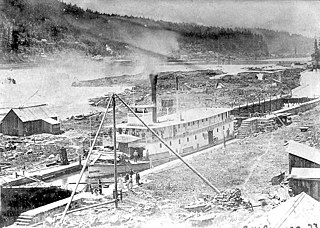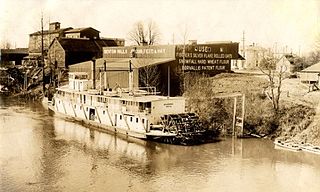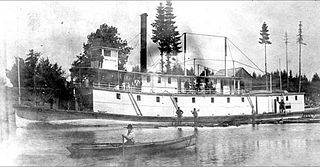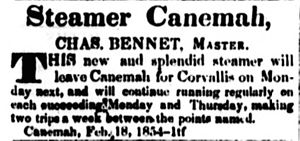Operations on the Willamette River
The upper Willamette River is much longer than the lower Willamette. The division between the two stretches of the river occurs at Willamette Falls, which was impassable to waterborne traffic. All cargoes bound further south than Oregon City had to be unloaded, portaged around the falls, and loaded again on vessels above the falls. For commercial purposes, the upper Willamette ran from above the falls to the head of navigation, and included important tributary rivers such as the Tualatin and the Yamhill. In the early 1850s the head of navigation was considered to be Corvallis, then known as Marysville.
Until 1851 no steam-powered vessel had ever run on the Upper Willamette. In 1851 several steamers arrived at just about the same time as Canemah. Most of the early vessels were smaller and did not run on regular schedules. Canemah was large for the time, and was the first steamer to enter regularly scheduled service. Canemah's first commanders were captains Bennett and McClosky. Typical freight of freight rates for Canemah was the charge of 20 cents per bushel for wheat shipped to Canemah from the Avery Brothers warehouse at Corvallis, which handled most of the grain then produced in Benton County.
The owners of Canemah were able to obtain the mail contract for the upper river, and the vessel became a floating post office for Nathaniel Coe, who was appointed the postal agent for the Oregon Territory in 1852. He sorted all the letters and packages as the vessel moved along the river, picking up and dropping off the mail at each landing. Canemah made the mail route twice a week between Canemah and Salem. Mail delivery was informal in those days, and it sometimes occurred that residents could wave a letter at a landing to flag the steamer down. [2] Canemah also operated on the Yamhill River up to the town of Lafayette. [4]
Steamers in those days in Oregon were fueled by wood, and they could burn four cords in an hour. What a steamer needed for regular operation were regular wood depots, which were called "wood yards." In the early 1850s woodyards were scarce along the Willamette River, and Canemah was forced to pay farmers five dollars a cord for wood. Few farmers were willing to cut wood and sell, so if Canemah could not embark sufficient fuel at a journey's outset, her trip might be cut short. [2]
In 1851, the Oregon territorial legislature voted to move the capital from Oregon City to Salem. In 1852 Canemah transported all the legislators and all the records of the territorial government upriver to Salem. On other occasions, Canemah carried territorial governor Joseph Lane and other officials. In 1854 the Hedges partners sold Canemah to the Citizens Accommodation Line, a concern organized by Captain George E. Cole and E.M. White. Cole and White also bought the Franklin (ex Shoalwater ex Fenix) and operated both vessels out of Canemah. The company had a carriage which hauled passengers up from Oregon City along the one or two-mile road to Canemah, where twice a week Canemah or Franklin departed twice weekly for Corvallis. [2] [4]

Canemah was an early settlement in the U.S. state of Oregon located near the Willamette River. Canemah was annexed to Oregon City in 1928.

The Willamette River flows northwards down the Willamette Valley until it meets the Columbia River at a point 101 miles from the Pacific Ocean, in the U.S. state of Oregon.

Gazelle was an early sidewheeler on the Willamette River in what is now the U.S. state of Oregon. She did not operate long, suffering a catastrophic boiler explosion on April 8, 1854, less than a month after her trial voyage. This was the worst such explosion ever to occur in the Pacific Northwest states. The wrecked Gazelle was rebuilt and operated for a few years, first briefly as the unpowered barge Sarah Hoyt and then, with boilers installed, as the steamer Señorita. A victim of the explosion was D.P. Fuller, age 28, who is buried in Lone Fir Cemetery in Portland, Oregon.

James D. Miller was a steamboat captain in the Pacific Northwest from 1851 to 1903. He became well known for his long length of service, the large number of vessels he commanded, and the many different geographical areas in which he served.

The Multnomah was one of the first steamboats to operate on the Willamette and Yamhill rivers. This vessel should not be confused with the Multnomah, a steamboat built in Portland, Oregon in 1885, which was larger and of a much different design.

The steamboat Shoalwater was the sixth steamer to operate on the upper Willamette River, which refers to the part of the river above Willamette Falls at Oregon City. In a short career of six years, Shoalwater was renamedFenix, Franklin, and Minnie Holmes. Shoalwater was the first steamboat in Oregon to suffer a boiler explosion, although no fatalities resulted.

Washington was an early steamboat operated in the states of California and Oregon. Washington was built in California and was initially operated on the Sacramento River. In 1851, the steamer was purchased and brought on a ship to the Oregon Territory, where it was operated on the Willamette River until the summer of 1853. Washington was sold again, and then transferred to the Oregon coast, where it operated on the Umpqua River, on the Coquille River and on Coos Bay. Washington was able to operate for shorter distances over the open ocean along the Oregon coast. The steamer was wrecked by a boiler explosion in December 1857, near Scottsburg, O.T., on the Umpqua river.

Pomona was a steamboat which operated on the Willamette, Columbia and Cowlitz rivers from 1898 to 1940. Pomona was specially designed to operate in low water conditions such as typically prevailed in the summer months in Oregon. Pomona was one of the few steamers that could regularly navigate to Corvallis, Oregon, which was the practical head of navigation on the Willamette. In 1926, Pomona was substantially rebuilt, and served afterwards as a towboat. In 1940, Pomona was converted into an unpowered floating storehouse.

Grahamona was a sternwheel steamboat built in 1912 for the Oregon City Transportation Company, commonly known as the Yellow Stack Line. Grahamona was specially designed to serve on the shallow waters of the upper Willamette River. It was one of the largest steamboats ever to operate on the upper Willamette. In 1920, Grahamona was sold and the name was changed to Northwestern. In 1939, the vessel was sold again, and transferred to Alaska for service on the Kuskokwim River.

Portland was a side wheel steamer built at Portland, Oregon in the summer of 1853. This vessel was chiefly remembered for its dramatic destruction in 1857 by being washed over Willamette Falls, an incident which killed its captain and a deckhand. The death of the captain, Arthur Jamieson, was one of at least four brothers, all steamboat officers, who were killed in three separate steamboating accidents occurring between 1857 and 1861 in Oregon and in British Columbia.

Wallamet was a sidewheel-driven steamboat that operated on the Willamette and Columbia rivers in Oregon and later on the Sacramento and San Joaquin rivers in California. Built in a Mississippi river style that was not suited to the conditions of these rivers, and suffering from construction defects, Wallamet was not a financially successful vessel. The name of this vessel is often seen spelled as Willamette.

Three Sisters was a sternwheel-driven steamboat that operated on the Willamette River from 1886 to 1896. The steamer was built as an extreme shallow-draft vessel, to permit it to reach points on the upper Willamette river such as Corvallis, Harrisburg and Eugene, Oregon during summer months when water levels in the river were generally low. The vessel was also known for having been washed up on a county road in Oregon during a flood in 1890.

Unio was a small sternwheel-driven steamboat which operated on the Willamette and Yamhill rivers from 1861 to 1869. This vessel is primarily remembered for its having been named Unio when built in 1861, in the first year of the American Civil War, and then having the name completed, to Union, by a new, staunchly pro-Union owner, James D. Miller. Union appears to have sunk in 1869, been salvaged, and then dismantled, with the machinery going to a new steamer then being built for service on the Umpqua River.

The People's Transportation Company operated steamboats on the Willamette River and its tributaries, the Yamhill and Tualatin rivers, in the State of Oregon from 1862 to 1871. For a brief time this company operated steamers on the Columbia River, and for about two months in 1864, the company operated a small steamer on the Clackamas River.

The Upper Willamette Transportation Line was a line of four inland steamboats that operated from the fall of 1859 to the summer of 1860 on the upper Willamette River in the state of Oregon, United States.

James Clinton was a steamboat which operated on the upper Willamette River from 1856 to 1861. Although the Clinton was said to have been "not a very good boat.", it was the first steamer ever to reach Eugene, Oregon. James Clinton was destroyed in April 1861, when a large fire broke out at Linn City, Oregon in a shoreside structure near to where the vessel was moored.

Dayton was a steamboat which operated on the Willamette and Columbia rivers from 1868 to 1881. Dayton operated on the Willamette from 1868 to 1876, mostly upriver from Willamette Falls, including a route on the Yamhill River to Dayton, Oregon, after which the steamer was named. From 1876 to 1881, Dayton was employed on a run from Portland to Monticello, W.T., which was located on the site of what is now Longview, Washington.

Albany was a stern-wheel driven steamboat that operated on the Willamette River from 1868 to 1875. This vessel should not be confused with the later sternwheeler Albany, which ran, also on the Willamette River, from 1896 to 1906, when it was rebuilt and renamed Georgie Burton.

Relief was a stern-wheel driven steamboat that operated on the Willamette River from 1858 to 1865. Relief ran for a short time on the route from Portland to Oregon City, Oregon. After being bought out by the competition, Relief was lined around Willamette Falls to the upper Willamette, where it became the first steamboat to reach Springfield. This vessel should not be confused with a later vessel, also named Relief, which operated on the Columbia and Lewis rivers from 1906 to 1931.

Fanny Patton was a stern-wheel driven steamboat that operated on the Willamette River, in Oregon, starting in August 1865. This steamer operated from 1865 to 1880 for various owners, and was a considered a profitable vessel. The steamer was named for the daughter of businessman Edwin N Cook, Frances Mary "Fannie" Cooke (1837–1886). Edwin N. Cook was one of the principals of the People's Transportation Company.



















